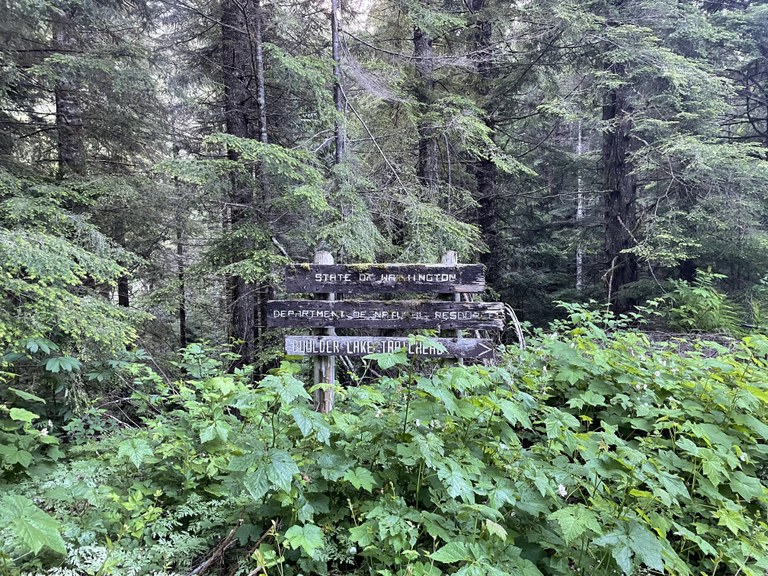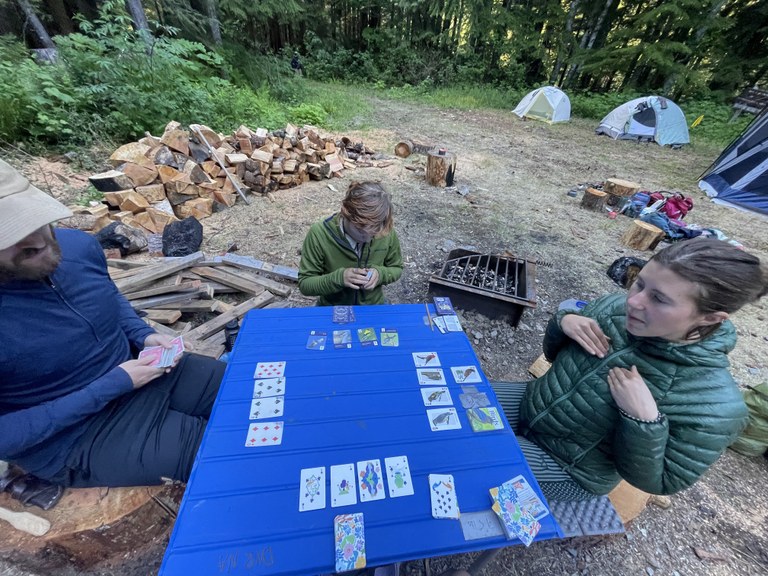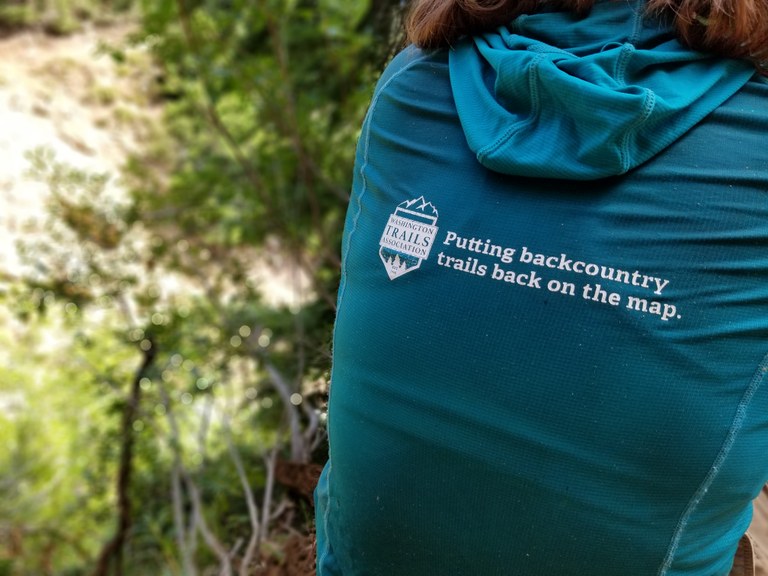 Washington Trails
Association
Washington Trails
Association
Trails for everyone, forever
Backcountry trail maintenance is more than trail tools and long days outside — it's the massive efforts of seasonal crew members, land managers and office coordination, and Zack Sklar helps make it happen. By Joseph Gonzalez
Washington’s backcountry trails are as rugged as they are beautiful. They’re also vulnerable. Threats like wildfires or lack of maintenance put them in jeopardy of being lost. That’s why every summer we send specialized trail crews deep into the backcountry to bring these trails back to life.
Our Lost Trails Found (LTF) trail maintenance work is committed to keeping those trails relevant and accessible, mobilizing three paid crews in tandem with volunteer backcountry crews to tackle these tough tasks. The paid trail work program has grown year over year, taking on fresh crew members, partnering with new land managers and working on bigger projects every summer. But, coordinating three professional WTA crews with multiple land managers across the state is a mountain of work. It’s enough to make a hiker’s head spin.
Enter Zack Sklar. He’s WTA’s Lost Trails Found Coordinator, and placing crews where they’re needed most is his job. It’s through land manager relationships, a professional development system curated by WTA and a deep understanding of Washington trails that he makes it possible for us to put these lost trails back on the map.

Meet WTA's Lost Trails Found Coordinator, Zack Sklar. Photo by Joseph Gonzalez
Zack’s the right person for this job because of his history with Lost Trails Found. His on-the-ground knowledge helps inform the decisions he makes from the office.
“I’ve grown in tandem with the Lost Trails Found program. My first year of professional trail work was the first year of LTF, so the program and I have been together the whole time.”
Zack joined the program back in its first year, when it was simply called the “Pro Crew”. Later, when the program grew into multiple crews, Zack began to lead and coordinate a crew at the same time, splitting time between field work and the office. Now in his fourth year with Lost Trails Found, Zack has transitioned into a more administrative role overseeing the crews and their projects.
“The LTF program is special to me because we’ve worked so hard to take feedback, change, grow and create a space in the outdoor industry that didn’t exist before. A space that is results driven, but also inclusive and welcoming. Every year we grow together.”
 Growing together and having fun is essential to the Lost Trails Found paid crews. Photo by Anna Roth
Growing together and having fun is essential to the Lost Trails Found paid crews. Photo by Anna Roth
The Lost Trails Found program’s continual investment in its crew members is central to the program’s success. Zack explains, “We try to hire people aligned with our values, then do everything we can to ensure they want to come back. If you have to train a brand-new crew each year, we’ll never progress as a program. But, if you can take people aligned with our values and build on their skills every year, then you’ll end up with a group of experienced pros who care about each other, care about the work and are awesome to hang out with in the woods.”
Zack is also quick to point out that every single returning member from the 2023 LTF crews are in leadership positions in 2024 as assistant crew leaders and crew leaders. This strong core of competent returners has allowed them to bring in new crew members each year with a diversity of backgrounds and experience levels, further broadening the skillset and deepening the community of the program.
“When I hear from a land manager we’re working with (like the Forest Service in the Entiat, or Washington Department of Natural Resources in the Mountain Loop Highway area), I’ll relay the information to our crew leader in the field. Sure, I coordinate scouts and projects, but at the end of the day the crew leaders and assistant crew leaders are the ones doing the work in the field. I want them to feel connected to what they’re doing and empowered to make their own decisions. It’s important to keep them involved in the conversations I’m having so they can continue to develop.”
“Each organization’s trail maintenance model is a little different. Sometimes one style of trail crew will be better suited for a specific job than another. We’re fortunate to have developed the breadth of expertise to work on a wide variety of projects, from backcountry logouts to technical rock projects in sensitive areas,” adds Zack.
They say the proof is in the pudding, but we prefer to say the proof is in the Pulaski.
Initially, our pro crews were funded by the Great American Outdoors Act (GAOA) as a way for the United States Forest Service (USFS) to reinvest funds through an organization with a strong trails program to keep their trails in great shape. The Great American Outdoors Act’s funding will expire through the fiscal year 2025, but the Lost Trails Found program has other sources of funding as well.
Private donor contributions have helped the program grow, and as Zack noted, the investment in the people on the crews pays off. As more people return, the crews skill set deepens and more land managers have taken notice of the LTF crew projects. Now, our Lost Trails Found professional crews are working with three land managers: the USFS, the Washington Department of Natural Resources (Washington DNR) and North Cascades National Park.

“In other areas, the forest service could get burn area rehabilitation funding to spend on their own paid crews. But fine-tuning a professional trail maintenance program takes time, and we offer a product that they can plug in right now to get immediate results.“
The support WTA gets from the USFS is partially from their Burned Area Emergency Response (BAER) program. Receiving funding from this source is a testament to the Forest Service’s faith in WTA’s ability to keep trails clear and safe as we move into a future where fire damage will be increasingly severe.
“We’re able to provide trail work at a professional level, making us a great candidate to help land managers invest their GAOA funding back into public lands,” says Zack.
Washington DNR also contributed to the program’s growth. Investment from Washington DNR is thanks to Zack, who helped establish the partnership.

Work with Washington DNR is bringing our crews to areas along the Mountain Loop Highway, like Boulder Lake. Photo by Mikayla Clarke
“Staffing a trail crew is a big undertaking, so sometimes a land manager like Washington DNR will rely on proven models like us, or the Washington Conservation Corps, to help with their projects.”
Trail maintenance coordination is an art. Backcountry trail work is seasonal and dynamic, and projects can change depending on unpredictable factors like wildfires, staff bandwidth and other logistical hurdles.
Zack doesn’t just assist with coordinating when and where we work — he also manages crewmembers day-to-day, plus contributes in small ways.
“My job is often a lot of little things,” explains Zack. “Today I dropped off some tools to our packing facility, refilled air in the tire of a company truck, printed out insurance cards and coordinated a materials drop-off for a puncheon project we’re working on in the Mountain Loop Highway area.”
If you’ve joined a WTA trail work party, you’ll know trail maintenance is fun, but also challenging. Just imagine doing it professionally in remote destinations, sometimes in rough weather for weeks at a time. It’s not just the manual labor that’s tough — managing health, work-life balance and seasonal burnout can also be hurdles.
Our professional crew program has access to mental health consultant Lauren Glass, a former WTA crew leader. She provides a “mental health first aid class” of sorts to the crews in the beginning of the season, plus is available as a resource throughout the season for 1:1 consultations for crew members. Lauren’s familiarity with our programming means she can offer especially relevant and useful tools and resources, keeping the crews at their healthiest all season long.

Seasonal work can be challenging to balance. Preventing burn-out is key. Photo by Michelle Mouw
The program has made big efforts, but Zack admits that some challenges remain present for professional trail crews at large: for professional WTA crews as well as those of our land manager partners.
“It’s hard to maintain a seasonal staff when finding affordable housing is so challenging in the Western Washington market, especially for employees who aren’t permanent residents to the area.”
Housing continues to be a hurdle for seasonal staff, and it is a challenge that often comes with the territory of seasonal workforces. But, for many seasonal crew members, a flexible lifestyle can be a preference.
“Seasonal employees generally like having seasonal jobs,” Zack explains, “Usually, by the time burnout sets in, it’s nearly winter and it’s time to move onto your winter seasonal job. For most LTF crew members, that’s a lifestyle we enjoy, and trail work helps facilitate it.”

It's a team effort — from office coordination to boots in the dirt — to put these trails back on the map. Photo by Joseph Gonzalez
Our professional trail maintenance program is always evolving to thrive in an ever-changing environment. Just like snowpack and seasonal weather can dictate wildfires season to season, so can land manager needs and available funding alter where our paid crews are most needed.
It takes a team of professionals and a network of relationships to ensure funds and trail work are distributed equitably to the areas that need them most. Zack and other WTA trails teammates like him who bring their boots in the dirt experience to their administrative roles make this work possible.